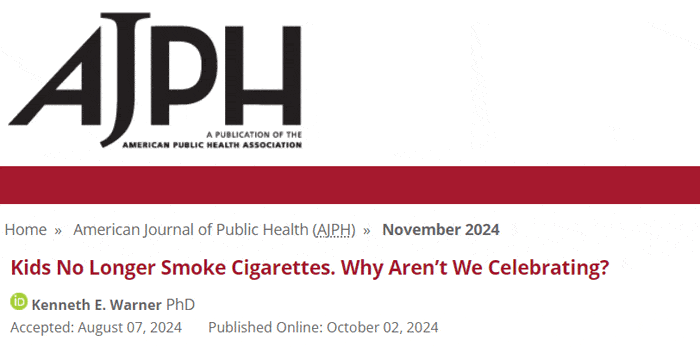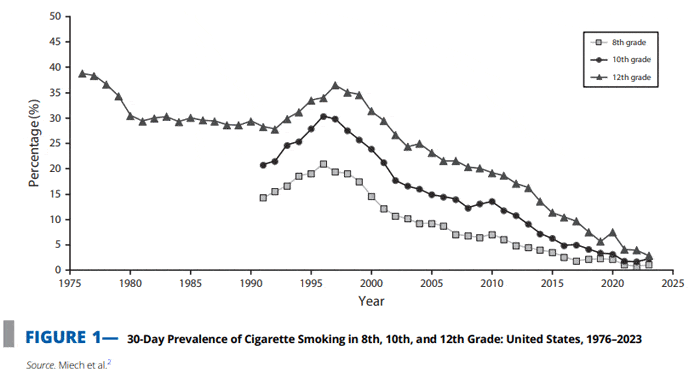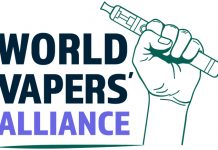An article has been published in AJPH (American Journal of Public Health) discussing recent trends in youth smoking. And the findings point to the fact that there is a decline in kids smoking / vaping in the US. Why aren’t we celebrating?
You can read the full article here – but I will summarise some of the main points below!
Introduction
The introduction states the following…
“The decrease in cigarette smoking among American youths is one of the great public health triumphs of the present century. Yet, few people are talking about it.
Public health agencies and tobacco control organizations mention it, if at all, in passing. Media coverage is minimal. Should we not be shouting it from the mountaintops?”
I totally agree!
Reasons To Celebrate!
The article covers the many contributing factors which have created this decline in youth smoking…
The graph below shows how only 1.9% of US high school students and 1.1% of middle school students report smoking at least once in the past 30 days.
They class past 30 day smoking as everything from 1 puff on a cigarette to daily use.
The figures for 12th graders rose to a peak of 36.5% in 1997 and for 10th graders the peak was in 1996 at 30.4%.
In the article the reasons for this are discussed and include the social stigma of smoking becoming less acceptable plus regulation changes.
Clear indoor air laws, advertising prohibition and price increases have also played a part in reducing this figure.
Impact Of Vaping
Of course another reason for the drop in smoking figures could be tied to the substitution of combustible tobacco for safer nicotine alternatives – including vaping.
The rate of vaping in US youth has dropped from 27.5% to 7.8% in high school students who have vaped in the last 30 days.
There is a concern that the 3% of current youth vapers have never smoked – but this is still a very small proportion in the scheme of things.
Youth vaping and smoking rates have been tied together.
Prior to the peak of youth vaping in 2019, 8.5% of high school seniors smoked tobacco daily in 2013. However after the peak in 2019 this rate dropped to 2.4% and then further to 0.7% in 2023. The daily vaping rates of 12th graders was 11.6% in 2019 and fell to 5.8% in 2023.
If you added these figures together to get an idea of total nicotine consumption (vaping + smoking) in 12th graders was 14% in 2019 and is now only 6.5% in 2023.
“This measure of likely nicotine addiction dropped by a quarter over the decade from before vaping to 2023, and today’s source of likely addiction, e-cigarettes, is substantially less dangerous than was the product in 2013, combustible cigarettes.”
Health Impact
According to the article, Lung Cancer is the leading cause of cancer death in both men and women. Smoking being responsible for 80-90% of those cases.
The article sums this up below…
“The near disappearance of smoking among today’s young people means that a few decades hence, lung cancer is likely to be a relatively minor cause of cancer. Deaths from chronic obstructive pulmonary disease—80% attributable to smoking—will likely fall as well, as may age-adjusted heart disease mortality.”
Conclusion
This is all extremely good news. Yes none of us want to see underage smokers or vapers, but the figures are all trending in an excellent direction.
It does make the moral panic revolving around vaping and nicotine in the US seem a bit of an overreaction!
“The rapid and nearly complete disappearance of adolescent smoking is arguably the single most dramatic, and ultimately important, tobacco control achievement to date.
Next on the docket is the elimination of adult smoking. Like youth smoking, adult smoking has declined substantially, albeit more slowly, to 11.5%. The benefits of the decrease are uneven, however. Reductions in smoking by younger adults have driven the decline.
Smoking has not decreased among older adults, the group most at risk for near-term illness and death. Twenty-eight million Americans smoke, and cigarettes continue to claim 480 000 lives every year.
Furthermore, the overall 11.5% prevalence masks significant disparities in prevalence and mortality.
Increasingly, smoking’s victims are society’s marginalized groups—people with lower income and education, those suffering from mental health problems, Indigenous people, and sexual and gender minoritized groups.
Having essentially eliminated youth smoking, it is time to focus attention on reducing adult smoking—the prize in tobacco control, according to the Surgeon General.”
This final passage really echoes my thoughts too…
“In the process, and perhaps as a model of success, let us celebrate the near elimination of cigarette smoking among our young people. They will live longer, healthier lives than their parents and grandparents.”
Yes I believe we should be celebrating the decline in kids smoking / vaping in the US and I hope the rest of the world takes note!
Responses
🔎 There is a profound and crucial piece just posted in the American Journal of Public Health @AMJPublicHealth by Dr. Ken Warner @umichsph, one of the most highly esteemed scholars in the field of tobacco research. Let’s take a close look.
1/🪡https://t.co/iDRACYxx8b pic.twitter.com/EYJnigM93o— American Vapor Manufacturers (@VaporAmerican) October 7, 2024
“Let us celebrate the near elimination of cigarette smoking among our young people. They will live longer, healthier lives than their parents and grandparents.” https://t.co/niBSpFarVa pic.twitter.com/82skRXT7fe
— Jonathan Foulds PhD (@JonathanFoulds) October 7, 2024
All while tobacco control warned us vaping would increase smoking, ever get the feeling you were being had?https://t.co/jnx2uFASC0
— NNA Ireland (@IrelandNna) October 8, 2024
“The decrease in cigarette smoking among American youths is one of the great public health triumphs of the present century. Yet, few people are talking about it.”
Great article by Prof Ken Warner outlines a number of reasons why… ⬇️https://t.co/58TFaZADZV
— Sarah Jackson (@DrSarahEJackson) October 7, 2024
“The decrease in #cigarette smoking among American youths is one of the great #publichealth triumphs of the present century. Yet few people are talking about it. Should we not be shouting it from the mountaintops?” asks Prof Ken Warner in @AMJPublicHealthhttps://t.co/qEDUfQNIzF
— The Global State of Tobacco Harm Reduction (@GlobalStateTHR) October 8, 2024
Two excellent recent articles on a similar theme regarding Smoking + Vaping numbers in US Youth.
Ken Warner = https://t.co/ceGGS5uGWX
Cheryl Olson = https://t.co/8ul2u9uRWN— Alan Beard (@Alan_Beard1) October 8, 2024
“Kids no longer smoke.”
The age of deadly cigarettes just ended. So why are health experts not dancing in the streets?Again: Why are the 10,000 US professionals who are currently employed in tobacco control still *pushing* alarm bells?#JobSecurityhttps://t.co/QU3eAHJqfO
— Charles A. Gardner, PhD (@ChaunceyGardner) October 7, 2024






